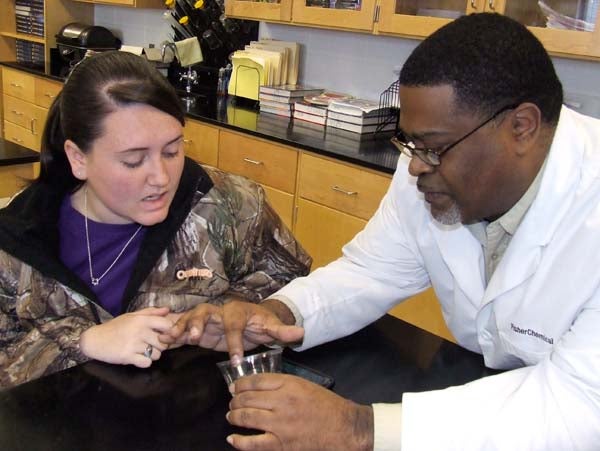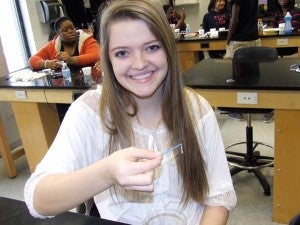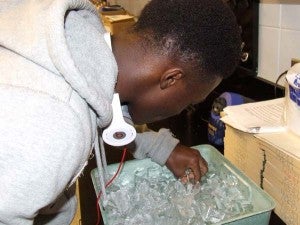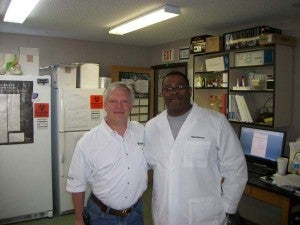In Dr. Sweet’s class, it’s all about DNA
Published 6:36 am Tuesday, March 5, 2013
Honors chemistry students in Dr. Joe Sweet’s class at Bainbridge High School are learning all about extracting DNA (deoxyribonucleic acid).
DNA is a long, strand-like molecule in which genes are written down in genetic code. DNA exists in the nucleus of every cell in the body and in the nucleus of every cell of every living thing. DNA determines almost all human characteristics, including height and hair color.
Anyone who watches CSI or other crime shows knows DNA is used in forensic science to either identify or clear perpetrators of a crime. It is also used to determine paternity of a child.
The students were curious about additional applications of DNA technology, and as a result, the curriculum evolved into one of ancestry, as more and more people today are using it to trace their ancestries.
Sweet’s class began the journey to “trace their ancestry as it is written in their genes.” Sweet explained that DNA is really who we are: many races, many faces, many differences, yet all of us are connected, and our connections run deeper than we may be willing to admit.
Sweet began a recent class by showing the students a DNA analysis kit he had ordered from the National Geographic Society. He will take swabs from his own cheeks and return them for testing. He told the students that by using similar techniques to the ones they are currently learning in class, scientists will be able to track genetic markers found in his DNA to tell the story of how his ancestry began, and perhaps even trace his ancestry back to the first male and female in his family from some 150,000 years ago.
In a recent class he instructed and led the students on how to extract each of their own DNA samples. Each student took a washing from his or her own cheek cells and proceeded to develop their own individual DNA in a little cup, following a procedure explained by Sweet, and reinforced with detailed instructions on a large screen TV mounted on the wall.
First, each student cleansed the mouth with plain water. After spitting it out, a drink of Gatorade was taken and swished around in the mouth for a full minute before being spit into a clear cup. Next, a drop or two of dish detergent was placed in the cup, and gently mixed in by gently swishing the cup. A pinch of meat tenderizer was added, and then a splash of alcohol. As the cup was left to rest, the “globby DNA stuff” began to form.
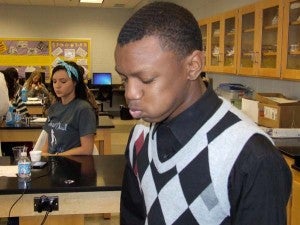
SWISHING GATORADE for a full minute, Courtney Murphy, a student in Dr. Sweet’s honors chemistry class, prepares to get a DNA sample.
The students watched their cups intently as Sweet moved around the room, checking the progress and announcing, “That’s your DNA.” The students began to fish the globs out with toothpicks, and carefully place it in a vial. Once the vial was marked with a name, it was placed in a large pan of ice cubes, preparatory to the next step.
Sweet said each DNA sample will be frozen, and can be stored for a long time. At the next class the students will practice how to make gels for use in gel electrophoresis, as well as use a polymerase chain reaction (PCR) machine called a Thermocycler that amplifies the DNA.
Sweet said he and the students are fortunate to be in a school that obtained the equipment through a competitive STEM (science, technology, engineering and math) grant. He credits Dr. Suzi Bonifay, Donna McGlincy and the school’s STEM program, which puts emphasis on science, technology, engineering and math.
Sweet said his course content is the result of his having served a four-week internship at Danimer last summer. He describes that experience as both eye and mind-opening.
“I encountered a life-changing moment at Danimer,” he said, and he has changed his teaching methods accordingly after being exposed to new technologies through the work of Dr. Daniel Carraway, Dr. Carol Leggett and Phil Van Trump.
Sweet decided to change his way of teaching to give his high school students the lab techniques that some colleges cannot even offer.
Following his internship, he wrote the action plan and classroom curriculum that he is following. He finds the students are opening their minds to possibilities they had never considered.
“It is all about taking real world technologies back to the classroom,” he said.


